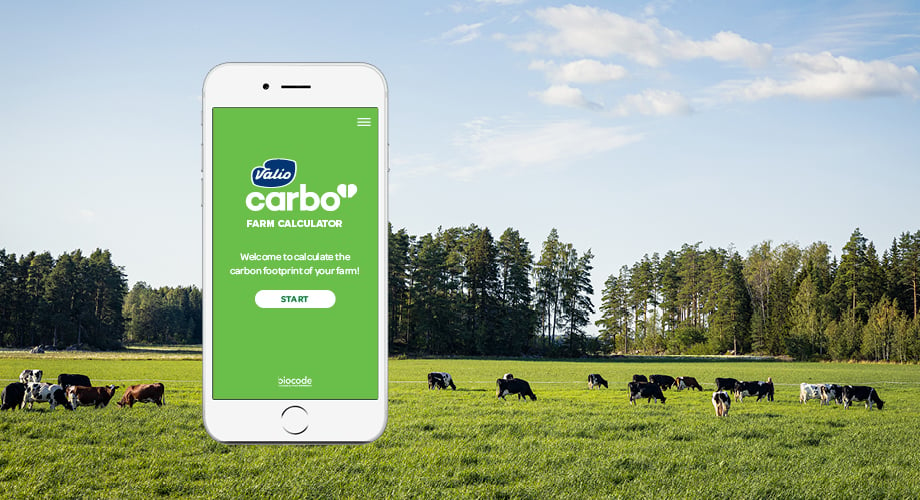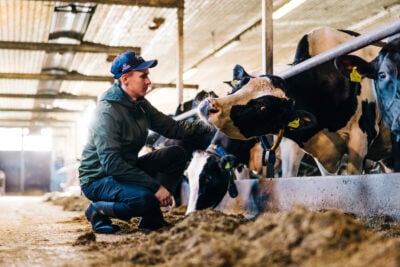The certified Valio Carbo® environmental calculator, developed for the Finnish climate and conditions, is used in monitoring the carbon balance of Valio dairy farms. In 2021, already more than thousand dairy farms, i.e. about a quarter of all Valio dairy farms, calculated the carbon footprint of the milk they produce. The calculated average carbon footprint of the milk produced at Valio dairy farms, i.e. raw milk, is 1.06 kilograms CO2e per litre. What makes the calculations significant is the fact that it covers 35 percent of the milk received by Valio and thus already about 28 percent of Finland’s total milk production. The global average carbon footprint of milk is about 2.5 CO2e per litre (FAO (http://www.fao.org/3/CA2929EN/ca2929en.pdf)).
The goal of Valio’s climate programme is to reset the carbon footprint of milk’s value chain to zero by 2035. The biggest emissions reductions can be achieved at dairy farms because about 85-95 percent of all the climate impacts of milk are generated in primary production. Additionally, Valio’s goal is to significantly reduce emissions also in its own production, i.e. in its factories, transports, and packaging.
Carbon footprint calculation guides emissions reductions but reveals little about actual climate impacts
More than anything, the carbon footprint is a tool and a means for monitoring success in reducing emissions. However, the figure doesn’t necessarily give a good indication of the climate impacts of individual products.
Valio Development Manager Aleksi Astaptsev has been developing Valio’s carbon footprint calculation for four years now and has trained 1,800 Valio dairy farmers in the use of the environmental calculator. According to him, the individual carbon footprint figures for food products are, at worst, misleading and meaningless because they tell you nothing without context and information about how the calculation was made.
“A carbon footprint calculation can be done in many different ways, and the result depends on the method of calculation. Likewise, the production conditions at farms also impact the carbon footprint of milk. The carbon footprint of the milk transported to Valio’s dairies typically varies between 0.7–1.4 CO2e per litre. We make the calculation at the most accurate level possible and with the actual figures of each farm, rather than using figures based on estimates,” Aleksi Astaptsev explains.
In addition to different methods of calculation, soil impacts, i.e. how much the soil binds or releases carbon, are still missing from the life-cycle assessment of agricultural products. There still isn’t enough research data on how much carbon can be sequestered in mineral soil with year-round grass farming, and how much carbon is emitted from peatland cultivation. The carbon footprint calculation also doesn’t take into account nutritional values. Instead of individual products, the entire meal and its nutrients should be considered.
“We don’t eat kilos; we eat nutrients in an effort to get the most balanced nutrition possible. Comparing completely different kinds of products makes no sense because no one eats, say, a kilo of cheese or a kilo of potatoes a day. It’s the totality that matters,” Aleksi Astaptsev says.
Dairy farmers have good feedback about the calculator
The Valio Carbo® environmental calculator gives dairy farmers an overall picture of the environmental impacts of their own farms: what has a big impact and what doesn’t. The result is comprised of the dairy farm’s activities: the carbon footprint is impacted by the number of arable hectares, the amount of grass farming, the number of cattle, the lifespan and productivity of the cows, the amount of energy and fuel used at the farm, and the forage fed to the cattle. The dairy farmers have provided very good feedback. The calculator is easy to use, and many dairy farmers are pleased when they see that the result is well below expectations.
“Finnish consumers are increasingly environmentally aware – which is purely a good thing. It is important to us that we can be part of the solution to the environmental impacts of food production and to produce milk for the products Finns can continue to buy with a good conscience also in the future. We believe that an increasing number of consumers value our work in sustainable food production,” says Rami Rauhala, a dairy farmer from Sievi.
“The target for 2021 was to have 500 dairy farms use the calculator. We are pleased that the interest in carbon footprint calculations has been so big that we doubled the target last year. Based on our target, all 4,000 Valio farms will have calculated their milk carbon footprint in 2024,” Aleksi Astaptsev adds.
No offset credits, just genuine actions to reduce own emissions
Aleksi Astaptsev feels that businesses should take ambitious actions to measure, report, and reduce their own emissions.
“Many products carry a label indicating that the product’s carbon emissions have been offset. Offset credits are typically allocated outside the production chain, e.g. to afforestation projects in developing countries. This does not change the actual carbon footprint of the product, and therefore, according to the Intergovernmental Panel on Climate Change (IPCC) guidelines, the offset credits should not be included in the carbon footprint, but should be referred to as carbon offsets. Producers should aim first to avoiding the generation of carbon emissions, then to reducing them, and only then to offsetting them,” he sums up.




